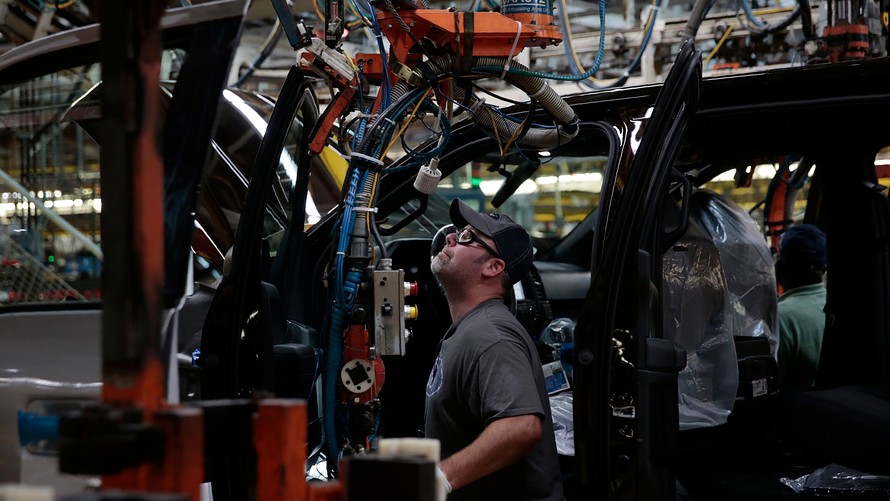
Manufacturing jobs growth has already stalled, and the trade war will make it worse
Over the summer, Indiana’s economy showed clear signs of weakening. This same story played out across the manufacturing and farming-intensive states of the Midwest.
To be sure, it is still easy to paint a rosy picture of our economy. Jobs are plentiful, pay has finally begun to rise and tax coffers are full. We are less than a year away from tying the longest recovery in U.S. history. Still, the warning signs are clear.
Nationally, manufacturing employment growth has slowed since April, and here in Indiana, it dipped into negative territory for two consecutive months. The index of leading economic indicators declined modestly since spring, and auto sales dropped sharply across spring and summer. The manufacturing portions of the Fed’s Midwest economic index have been negative for four months.
It’s risky to draw conclusions from a single six-month period, but growing evidence suggests manufacturing growth stalled over the summer. There’s more.
This is a stunningly beautiful season in the Midwest, when combines harvesting soybeans fill the fields on warm October days. Driving by these fields, I often wonder what majesty and dignity a modern Winslow Homer might portray in this setting. However, even in these idyllic scenes, all is not good. Most of these fields contain crops that will be harvested at a painful loss. Prices are down, and that fact is revealed in the slowing purchases of farm machinery across the Midwest.
Hoosiers should view the marked slowdown of our two largest industries with alarm. That the cause of this slowdown is clearly our widening trade war, which should provide even more reason for worry. To be clear, the worst is yet to come as both tariffs and their lagging effects will plague us well into 2019.
What is worse is that this is bad medicine treating the wrong problem. Let me explain.
Over the past 50 years, American jobs have steadily moved away from factories, mimicking the shift from farm to factory in the 50 years before that. The cause of each phenomenon was largely the same: technology, automation and the associated productivity growth meant we needed fewer workers to produce even more goods.
Naturally, these changes, like those before them, disrupted households. But, the problem was never the economic restructuring or technology. Economic change is a three-century-old force across western civilization. Most people and places didn’t merely adapt, they thrived. Sadly, many places in the Midwest have neither adapted nor thrived.
The causal factor in the decline of many Midwest places was simply dogged, stubborn, almost prideful ignorance about century-long changes to the world economy.
The Rust Belt is full of households and communities who ignored decades-old trends. Peak manufacturing employment in the Midwest is nearly five decades behind us, when Chinese and Mexican exports were trivial. Yet, far too many communities continued to pursue “jobs attraction” policies that failed them since the 1960s. This was costly, in both dollars and common sense. The wholly unrealistic promise of “new factory jobs” eased the pressure on schools and families to improve the education of their children, and invited mis-spending of tax dollars.
There is no easy way to phrase the truth, so let me say it plainly. The causal factor in the decline of many Midwest places was simply dogged, stubborn, almost prideful ignorance about century-long changes to the world economy. Not only has this saddled communities with decades of mis-investment, it has mistakenly convinced millions of Midwesterners that factory jobs may once again be plentiful. They won’t; even as manufacturing production will continue to expand, employment will not.
Into this landscape of false promises, came the 2016 election. The main players, Donald Trump, Bernie Sanders and Hillary Clinton, spoke easily about the evils of trade, wholly misrepresenting facts. To their credit, the remaining GOP candidates did not. And, in an underappreciated farewell speech, President Obama made it quite plain “. . . the next wave of economic dislocation won’t come from overseas. It will come from the relentless pace of automation that makes many good, middle-class jobs obsolete.” Like him or not, that statement is as true and obvious as the rising sun.
Even as manufacturing production will continue to expand, employment will not.
Ignoring almost the whole of those truths, today we pursue a trade war. We impose tariffs without thought, and invite retaliatory tariffs by allies and foes alike. By mid-winter, our tariffs on major trading partners will approach those set during the fiasco of protectionism that marked the Great Depression. This will undo 75 years of American efforts to reduce barriers to trade across the world. It will also pummel the Midwest, early and hard.
It is ironic that the very places that ignored the economic changes of the past half-century will be the first to feel the spreading pain of this bad medicine. It is fitting, of course, but ironic nonetheless. The only good option is to claim victory and end the trade war before it claims more victims. As we are slow to learn, that is unlikely to happen. Far more likely is a recession in which millions of Americans come to understand the value of free trade the hard way.


